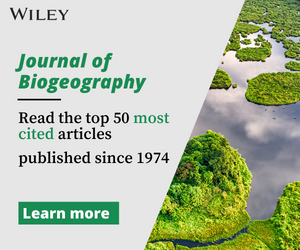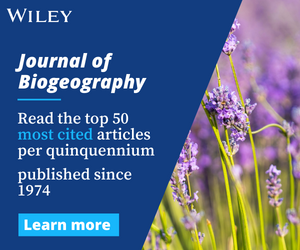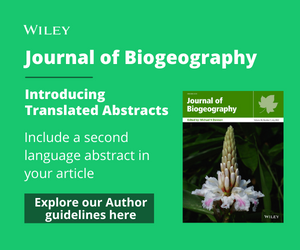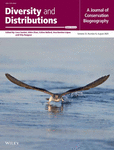Overview
Aims and Scope
SCOPE:
The Journal of Biogeography publishes research at the intersection of biology and geography that is scientifically important and of broad general interest. We seek papers describing patterns and revealing mechanisms that shape biodiversity, through time, throughout the planet, from the deep past into the future, and from local to global scales. Papers in any area of biogeography are welcome, and should clearly articulate their theoretical foundations and the conceptual advances they contribute. Diverse approaches are encouraged—including ecological, evolutionary, genomic, geographic, empirical, theoretical—from molecules to ecosystems and from microbes to plants and megafauna. Through this broad and inclusive scope, we aim for papers in Journal of Biogeography to address understudied, vexing, and urgent questions and to advance basic understanding of the origins, distributions, and fates of all life on Earth.
Manuscripts submitted to Journal of Biogeography should be original and innovative, concise, well written, rigorously analyzed and argued, and consequential. While many such studies will be multifaceted, comparative, and draw generalities, we also welcome exceptional case studies that illustrate particularly interesting deviations that, in their aggregate, shift preconceptions.
Journal of Biogeography supports FAIR principles and open data, accessibility to publish and read, and a constructive peer-review process.
VISION:
The Journal of Biogeography is the discipline’s first and foremost journal. Its established history publishing influential papers in biogeography, its topical breadth, and its strong reputation in the community, provide the foundation for the journal to continue to grow as the most respected journal in the field. Nonetheless, as disciplinary and publishing trends change, to remain at the forefront of biogeography, the journal must innovate such that it represents not only core biogeography but also novel advances in emerging areas. Biogeography is an integrative discipline and the journal aims to increasingly complement its strong foundations with the most exciting multidisciplinary research.
The journal was established in 1974 and is a sister publication to Global Ecology and Biogeography and Diversity and Distributions. The three journals have distinct but complementary focus areas within the broad field of biogeography.
Global Ecology and Biogeography (GEB) welcomes papers that investigate broad-scale (in space, time and/or taxonomy), general patterns in the organization of ecological systems and assemblages, and the processes that underlie them. In particular, GEB welcomes studies that use macroecological methods, comparative analyses, meta-analyses, reviews, spatial analyses and modelling to arrive at general, conceptual conclusions. Studies in GEB need not be global in spatial extent, but the conclusions and implications of the study must be relevant to ecologists and biogeographers globally, rather than being limited to local areas, or specific taxa. Similarly, GEB is not limited to spatial studies; we are equally interested in the general patterns of nature through time, among taxa (e.g., body sizes, dispersal abilities), through the course of evolution, etc. Further, GEB welcomes papers that investigate general impacts of human activities on ecological systems in accordance with the above criteria. Global Ecology and Biogeography generally does not publish studies that focus on unique events or places, or on specific taxa in local areas. The journal is also not interested in studies that lack ecological and/or biogeographical focus
Diversity and Distributions is a journal of conservation biogeography. We publish papers that deal with the application of biogeographical principles, theories, and analyses to problems concerning the conservation of biodiversity. Appropriate topics include innovative applications or methods of species distribution modelling; the application of island biogeographic principles to conservation; developing paradigms, models and frameworks for conservation planning and risk assessment; or identifying the agents of global change, including how climate change, land use change and invasive species affect the abundance, distribution, and range boundaries of native species. Papers must meet four criteria to be considered for publication: (1) They must have a strong biogeographic focus with clear conservation implications, or a strong conservation focus on biogeographic patterns or principles, (2) submissions must test clear hypotheses or predictions arising from theory, or derive novel insights from biogeographic patterns and biodiversity trends, (3) they must be presented clearly and concisely, and (4) their results must have clear and important implications for our understanding of biogeography and must be of potential broad interest of the readership.
Keywords
algae, animals, biodiversity, climate, conservation biology, data science, ecosystems, evolution, fungi, genomics, geodiversity, geography, geology, invertebrates, plants, macroecology, methods, microbes, paleoecology, paleontology, population genetics, phylogenetics, phylogeography, remote sensing, spatial ecology, theory, traits, vertebrates.
Abstracting and Indexing Information
- Academic Search (EBSCO Publishing)
- Academic Search Alumni Edition (EBSCO Publishing)
- Academic Search Premier (EBSCO Publishing)
- AgBiotech News & Information (CABI)
- AgBiotechNet (CABI)
- AGRICOLA Database (National Agricultural Library)
- Agricultural & Environmental Science Database (ProQuest)
- Animal Breeding Abstracts (CABI)
- BIOBASE: Current Awareness in Biological Sciences (Elsevier)
- Biocontrol News & Information (CABI)
- Biological & Agricultural Index Plus (EBSCO Publishing)
- Biological Abstracts (Clarivate Analytics)
- Biological Science Database (ProQuest)
- BIOSIS Previews (Clarivate Analytics)
- CAB Abstracts® (CABI)
- Crop Physiology Abstracts (CABI)
- Current Contents: Agriculture, Biology & Environmental Sciences (Clarivate Analytics)
- Earth, Atmospheric & Aquatic Science Database (ProQuest)
- Environment Index (EBSCO Publishing)
- Field Crop Abstracts (CABI)
- GEOBASE (Elsevier)
- GeoRef (AGI)
- Global Health (CABI)
- Grasslands & Forage Abstracts (CABI)
- Helminthological Abstracts (CABI)
- Horticultural Science Abstracts (CABI)
- InfoTrac (GALE Cengage)
- Irrigation & Drainage Abstracts (CABI)
- Journal Citation Reports/Science Edition (Clarivate Analytics)
- Leisure Tourism Database (CABI)
- Leisure, Recreation & Tourism Abstracts (CABI)
- Maize Abstracts (CABI)
- Natural Science Collection (ProQuest)
- Nutrition Abstracts & Reviews Series B: Livestock Feeds & Feeding (CABI)
- Ornamental Horticulture (CABI)
- Plant Breeding Abstracts (CABI)
- Plant Genetic Resources Abstracts (CABI)
- Poultry Abstracts (CABI)
- Protozoological Abstracts (CABI)
- PubMed Dietary Supplement Subset (NLM)
- Review of Agricultural Entomology (CABI)
- Review of Aromatic & Medicinal Plants (CABI)
- Review of Medical & Veterinary Entomology (CABI)
- Review of Medical & Veterinary Mycology (CABI)
- Review of Plant Pathology (CABI)
- Rural Development Abstracts (CABI)
- Science Citation Index (Clarivate Analytics)
- Science Citation Index Expanded (Clarivate Analytics)
- SciTech Premium Collection (ProQuest)
- SCOPUS (Elsevier)
- Seed Abstracts (CABI)
- Soils & Fertilizers Abstracts (CABI)
- Soybean Abstracts Online (CABI)
- Sugar Industry Abstracts (CABI)
- Tropical Diseases Bulletin (CABI)
- Veterinary Bulletin (CABI)
- VINITI (All-Russian Institute of Science & Technological Information)
- Weed Abstracts (CABI)
- Wheat, Barley & Triticale Abstracts (CABI)
- World Agricultural Economics & Rural Sociology Abstracts (CABI)
- Zoological Record (Clarivate Analytics)








